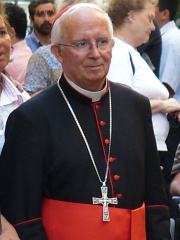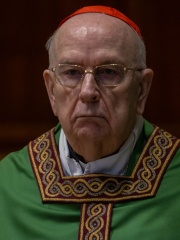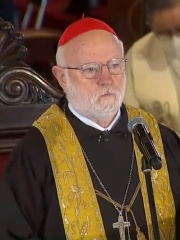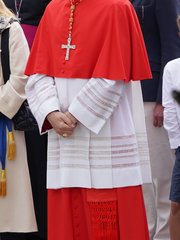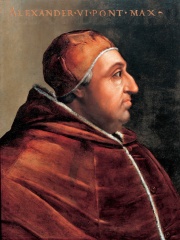


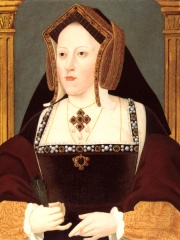



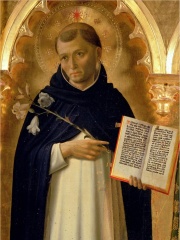
The Most Famous
RELIGIOUS FIGURES from Spain
This page contains a list of the greatest Spanish Religious Figures. The pantheon dataset contains 3,187 Religious Figures, 119 of which were born in Spain. This makes Spain the birth place of the 7th most number of Religious Figures behind United States, and United Kingdom.
Top 10
The following people are considered by Pantheon to be the top 10 most legendary Spanish Religious Figures of all time. This list of famous Spanish Religious Figures is sorted by HPI (Historical Popularity Index), a metric that aggregates information on a biography's online popularity. Visit the rankings page to view the entire list of Spanish Religious Figures.

1. Pope Alexander VI (1431 - 1503)
With an HPI of 85.46, Pope Alexander VI is the most famous Spanish Religious Figure. His biography has been translated into 90 different languages on wikipedia.
Pope Alexander VI (Italian: Alessandro VI, Valencian: Alexandre VI, Spanish: Alejandro VI; born Roderic Llançol i de Borja; epithet: Valentinus ("The Valencian"); c. 1431 – 18 August 1503) was head of the Catholic Church and ruler of the Papal States from 11 August 1492 until his death in 1503. Born into the prominent Borja family in Xàtiva in the Kingdom of Valencia under the Crown of Aragon (in present-day Spain), he was known as Roderic de Borja, and he is commonly referred to by the Italianized form as Rodrigo Borgia. He studied law at the University of Bologna. He was ordained deacon and made a cardinal in 1456 after the election of his uncle as Pope Callixtus III, and a year later he became vice-chancellor of the Catholic Church. He proceeded to serve in the Roman Curia under the next four popes, acquiring significant influence and wealth in the process. In 1492, Rodrigo was elected pope, taking the name Alexander VI. Alexander's papal bulls of 1493 confirmed or reconfirmed the rights of the Spanish crown in the New World following the finds of Christopher Columbus in 1492. During the second Italian war, Alexander VI supported his son Cesare Borgia as a condottiero for the French king. The scope of his foreign policy was to gain the most advantageous terms for his family. Alexander is one of the most controversial of the Renaissance popes, partly because he acknowledged fathering several children by his mistresses. As a result, his Italianized Valencian surname, Borgia, became a byword for libertinism and nepotism, which are traditionally considered as characterizing his pontificate.

2. Ignatius of Loyola (1491 - 1556)
With an HPI of 83.89, Ignatius of Loyola is the 2nd most famous Spanish Religious Figure. His biography has been translated into 86 different languages.
Ignatius of Loyola ( ig-NAY-shəs; Basque: Ignazio Loiolakoa; Spanish: Ignacio de Loyola; Latin: Ignatius de Loyola; born Íñigo López de Oñaz y Loyola; c. 23 October 1491 – 31 July 1556), venerated as Saint Ignatius of Loyola, was a Spanish Catholic priest and theologian, who, with six companions, founded the religious order of the Society of Jesus (Jesuits), and became its first Superior General, in Paris in 1541. Ignatius envisioned the purpose of the Society of Jesus to be missionary work and teaching. In addition to the vows of chastity, obedience and poverty of other religious orders in the church, Loyola instituted a fourth vow for Jesuits of obedience to the Pope, to engage in projects ordained by the pontiff. Jesuits were instrumental in leading the Counter-Reformation. As a former soldier, Ignatius paid particular attention to the spiritual formation of his recruits and recorded his method in the Spiritual Exercises (1548). In time, the method has become known as Ignatian spirituality. He was beatified in 1609 and was canonized as a saint on 12 March 1622. His feast day is celebrated on 31 July. He is the patron saint of the Basque provinces of Gipuzkoa and Biscay as well as of the Society of Jesus. He was declared the patron saint of all spiritual retreats by Pope Pius XI in 1922.

3. Saint Lawrence (225 - 258)
With an HPI of 83.00, Saint Lawrence is the 3rd most famous Spanish Religious Figure. His biography has been translated into 62 different languages.
Saint Lawrence or Laurence (Latin: Laurentius, lit. 'laurelled'; 31 December 225 – 10 August 258) was one of the seven deacons of the city of Rome under Pope Sixtus II who were martyred in the persecution of the Christians ordered by the Roman emperor Valerian in 258.

4. Catherine of Aragon (1485 - 1536)
With an HPI of 81.80, Catherine of Aragon is the 4th most famous Spanish Religious Figure. Her biography has been translated into 75 different languages.
Catherine of Aragon (also spelt as Katherine, historical Spanish: Catharina, now: Catalina; 16 December 1485 – 7 January 1536) was Queen of England as the first wife of King Henry VIII from their marriage on 11 June 1509 until its annulment on 23 May 1533. She had previously been Princess of Wales while married to Henry's elder brother, Arthur, Prince of Wales, for a short period before his death. Catherine was born at the Archbishop's Palace of Alcalá de Henares, and was the youngest child of Isabella I of Castile and Ferdinand II of Aragon. She was three years old when she was betrothed to Arthur, the eldest son of Henry VII of England. They married in 1501, but Arthur died five months later. Catherine spent years in limbo, and during this time, she held the position of ambassador of the Aragonese crown to England in 1507, the first known female ambassador in European history. She married Henry VIII shortly after his accession in 1509. For six months in 1513, she served as regent of England while Henry was in France. During that time the English defeated a Scottish invasion at the Battle of Flodden, an event in which Catherine played an important part with an emotional speech about courage and patriotism. By 1526, Henry was infatuated with Anne Boleyn and dissatisfied that his marriage to Catherine had produced no surviving sons, leaving their daughter Mary as heir presumptive at a time when there was no established precedent for a woman on the throne. He sought to have their marriage annulled, setting in motion a chain of events that led to England's schism with the Catholic Church. When Pope Clement VII refused to annul the marriage, Henry defied him by assuming supremacy over religious matters in England. In 1533, their marriage was consequently declared invalid and Henry married Anne on the judgement of clergy in England, without reference to the pope. Catherine refused to accept Henry as supreme head of the Church in England and considered herself the King's rightful wife and queen, attracting much popular sympathy. Despite this, Henry acknowledged her only as dowager princess of Wales. After being banished from court by Henry, Catherine lived out the remainder of her life at Kimbolton Castle, dying there in January 1536 of cancer. The English people held Catherine in high esteem, and her death set off tremendous mourning. Her daughter Mary became the first undisputed English queen regnant in 1553. Catherine commissioned The Education of a Christian Woman by Juan Luis Vives, who dedicated the book, controversial at the time, to the Queen in 1523. Such was Catherine's impression on people that even her adversary Thomas Cromwell said of her, "If not for her sex, she could have defied all the heroes of History." She successfully appealed for the lives of the rebels involved in the Evil May Day, for the sake of their families, and also won widespread admiration by starting an extensive programme for the relief of the poor. Catherine was a patron of Renaissance humanism and a friend of the great scholars Erasmus of Rotterdam and Thomas More.

5. Pope Callixtus III (1379 - 1458)
With an HPI of 81.78, Pope Callixtus III is the 5th most famous Spanish Religious Figure. His biography has been translated into 77 different languages.
Pope Callixtus III (Italian: Callisto III, Valencian: Calixt III, Spanish: Calixto III; 31 December 1378 – 6 August 1458), born Alonso de Borja, but referred to in English-language accounts as Alfonso de Borgia as a member of the House of Borgia, was head of the Catholic Church and ruler of the Papal States from 8 April 1455 to his death, in August 1458. Borgia spent his early career as a professor of law at the University of Lleida; he later served as a diplomat for the kings of Aragon. He became a tutor for King Alfonso V's illegitimate son Ferdinand. After arranging a reconciliation between Alfonso and Pope Martin V, Borgia was made Bishop of Valencia. In 1444, Pope Eugene IV named him a cardinal, and Borgia became a member of the Roman Curia. During the siege of Belgrade (1456), Callixtus initiated the custom that bells be rung at midday to remind the faithful to pray for the crusaders. The tradition of the Angelus noon bell still exists in most Catholic churches to this day. He was also responsible for the retrial of Joan of Arc that saw her vindicated. He appointed two nephews as cardinals, one of whom became Pope Alexander VI. He is the last pope to date to take on the pontifical name "Callixtus".

6. Francis Xavier (1506 - 1552)
With an HPI of 81.55, Francis Xavier is the 6th most famous Spanish Religious Figure. His biography has been translated into 77 different languages.
Francis Xavier, (born Francisco de Jasso y Azpilicueta; Latin: Franciscus Xaverius; Basque: Xabierkoa; French: François Xavier; Spanish: Francisco Javier; Portuguese: Francisco Xavier; 7 April 1506 – 3 December 1552) venerated as Saint Francis Xavier, was a Navarrese cleric and missionary. He co-founded the Society of Jesus and, as a representative of the Portuguese Empire, led the first Christian mission to Japan. Born in the town of Xavier, Kingdom of Navarre, he was a companion of Ignatius of Loyola and one of the first seven Jesuits who took vows of poverty and chastity at Montmartre, Paris in 1534. He led extensive missionary work across Asia, primarily within the Portuguese Empire in the East, and played a significant role in the evangelization of early modern India, particularly through his activities in Portuguese India. In 1546, Francis Xavier wrote to King John III of Portugal proposing measures to strengthen the Christian faith in Goa. Some historians interpret this letter as a request for the establishment of the Goan Inquisition, while others contend that he instead called for the appointment of a special minister dedicated solely to promoting Christianity in Goa. As a representative of the King of Portugal, he was the first major Christian missionary to venture into Borneo, the Maluku Islands, Japan, and other areas. In those areas, struggling to learn the local languages and in the face of opposition, he had less success than he had enjoyed in India. Xavier also extended his mission to Ming China, where he died on Shangchuan Island. He was beatified by Pope Paul V on 25 October 1619 and canonized by Pope Gregory XV on 12 March 1622. In 1624, he was made co-patron of Navarre. Known as the "Apostle of the Indies", "Apostle of the Far East", "Apostle of China" and "Apostle of Japan", he is considered to be one of the greatest missionaries since Paul the Apostle. In 1927, Pope Pius XI published the decree Apostolicorum in Missionibus naming Francis Xavier, along with Thérèse of Lisieux, co-patron of all foreign missions. He is now co-patron saint of Navarre, along with Saint Fermin. The "Day of Navarre" marks the anniversary of Francis Xavier's death, on 3 December.

7. Maimonides (1138 - 1204)
With an HPI of 81.42, Maimonides is the 7th most famous Spanish Religious Figure. His biography has been translated into 87 different languages.
Moses ben Maimon, commonly known as Maimonides and also referred to by the Hebrew acronym Rambam, was a Sephardic Jewish rabbi who is widely acknowledged as one of the most prolific and influential Torah scholars of the Middle Ages. Originally from Córdoba, where he was born on Passover Eve of 1135 or 1138, his family was exiled from Muslim-ruled Spain when they refused to convert to Islam shortly after the Almohad Caliphate conquered the Almoravid Caliphate in 1148. Over the course of the next two decades, Maimonides resided in Fez, Acre, Jerusalem, Alexandria, and Cairo before finally settling in Fustat between 1168 and 1171. During this period, he advanced his vocations and became renowned for his achievements as an astronomer, philosopher, and physician—even being appointed to serve as personal physician to Saladin of the Ayyubid Sultanate. Most contemporary Jews as far as Iraq and Yemen greeted Maimonides' writings on halakha and Jewish ethics with acclaim and gratitude. Yet, while he rose to lead the Jewish community in Egypt, he also had vociferous critics, particularly in Spain. He continued to live in Fustat until his death in 1204 and is said to have been buried in Tiberias. Accordingly, the Tomb of Maimonides in Tiberias holds importance as a Jewish pilgrimage site. To date, Maimonides is recognized as one of the foremost rabbinic decisors and his copious work comprises a cornerstone of Jewish scholarship. His fourteen-volume Mishneh Torah still carries significant canonical authority in Judaism as a codification of halakha, as do his thirteen principles of faith. Maimonides' era is considered by many to mark the end of the Jewish Golden Age in Spain, owing to the ubiquitous persecution of his family and the Sephardic Jewish community in general, though others assert that it lasted until the Christian Reconquista concluded in the 15th century. Aside from being revered by Jewish historians, Maimonides features very prominently in the history of Islamic science. Influenced by Aristotle, al-Farabi, ibn Sina, and his contemporary ibn Rushd, his work as a polymath contributed to the Islamic Golden Age and was regarded highly in many parts of the Muslim world.

8. Teresa of Ávila (1515 - 1582)
With an HPI of 80.81, Teresa of Ávila is the 8th most famous Spanish Religious Figure. Her biography has been translated into 74 different languages.
Teresa of Ávila (born Teresa Sánchez de Cepeda Dávila y Ahumada; 28 March 1515 – 4 or 15 October 1582), also called Saint Teresa of Jesus, was a Carmelite nun and prominent Spanish mystic and religious reformer. Active during the Counter-Reformation, Teresa became the central figure of a movement of spiritual and monastic renewal, reforming the Carmelite Orders of both women and men. The movement was later joined by the younger Carmelite friar and mystic Saint John of the Cross, with whom she established the Discalced Carmelites. A formal papal decree adopting the split from the old order was issued in 1580. Her autobiography, The Life of Teresa of Jesus, and her books The Interior Castle and The Way of Perfection are prominent works on Christian mysticism and Christian meditation practice. In her autobiography, written as a defense of her ecstatic mystical experiences, she discerns four stages in the ascent of the soul to God: mental prayer and meditation; the prayer of quiet; absorption-in-God; ecstatic consciousness. The Interior Castle, written as a spiritual guide for her Carmelite sisters, uses the illustration of seven mansions within the castle of the soul to describe the different states one's soul can be in during life. Forty years after her death, in 1622, Teresa was canonized by Pope Gregory XV. On 27 September 1970 Pope Paul VI proclaimed Teresa the first female Doctor of the Church in recognition of her centuries-long spiritual legacy to Catholicism.

9. Saint Dominic (1170 - 1221)
With an HPI of 79.42, Saint Dominic is the 9th most famous Spanish Religious Figure. His biography has been translated into 65 different languages.
Saint Dominic, (Spanish: Santo Domingo; 8 August 1170 – 6 August 1221), also known as Dominic de Guzmán (Spanish: [ɡuθˈman]), was a Castilian Catholic priest and the founder of the Dominican Order. He is the patron saint of astronomers and natural scientists, and he and his order are traditionally credited with spreading and popularizing the rosary.

10. Isidore of Seville (560 - 636)
With an HPI of 78.62, Isidore of Seville is the 10th most famous Spanish Religious Figure. His biography has been translated into 68 different languages.
Isidore of Seville (Latin: Isidorus Hispalensis; c. 560 – 4 April 636) was a Hispano-Roman scholar, theologian and archbishop of Seville. He is widely regarded, in the words of the 19th-century historian Charles Forbes René de Montalembert, as "the last scholar of the ancient world". At a time of disintegration of classical culture, aristocratic violence, and widespread illiteracy, Isidore was involved in the conversion of the Arian Visigothic kings to Catholicism, both assisting his brother Leander of Seville and continuing after Leander's death. He was influential in the inner circle of Sisebut, Visigothic king of Hispania. Like Leander, he played a prominent role in the Councils of Toledo and Seville. His fame after his death was based on his Etymologiae, an etymological encyclopedia that assembled extracts of many books from classical antiquity that would otherwise have been lost. This work also helped to standardise the use of the full stop, comma and colon. Since the Early Middle Ages, Isidore has sometimes been called Isidore the Younger or Isidore Junior (Latin: Isidorus iunior), because of the earlier history purportedly written by Isidore of Córdoba.
People
Pantheon has 119 people classified as Spanish religious figures born between 225 and 1977. Of these 119, 22 (18.49%) of them are still alive today. The most famous living Spanish religious figures include Joan Enric Vives Sicília, Carlos Osoro Sierra, and Antonio Cañizares Llovera. The most famous deceased Spanish religious figures include Pope Alexander VI, Ignatius of Loyola, and Saint Lawrence. As of April 2024, 4 new Spanish religious figures have been added to Pantheon including Ángel Fernández Artime, José Cobo Cano, and François Bustillo.
Living Spanish Religious Figures
Go to all RankingsJoan Enric Vives Sicília
1949 - Present
HPI: 76.00
Carlos Osoro Sierra
1945 - Present
HPI: 66.57
Antonio Cañizares Llovera
1945 - Present
HPI: 66.14
Luis Ladaria Ferrer
1944 - Present
HPI: 66.10
Santos Abril y Castelló
1936 - Present
HPI: 65.26
Fernando Vérgez Alzaga
1945 - Present
HPI: 65.10
Juan José Omella
1946 - Present
HPI: 63.40
Celestino Aós Braco
1945 - Present
HPI: 62.65
Julián Herranz Casado
1930 - Present
HPI: 62.56
Lluís Martínez Sistach
1937 - Present
HPI: 62.37
Antonio María Rouco Varela
1936 - Present
HPI: 61.90
Josep Maria Mauri
1941 - Present
HPI: 61.56
Deceased Spanish Religious Figures
Go to all RankingsPope Alexander VI
1431 - 1503
HPI: 85.46
Ignatius of Loyola
1491 - 1556
HPI: 83.89
Saint Lawrence
225 - 258
HPI: 83.00
Catherine of Aragon
1485 - 1536
HPI: 81.80
Pope Callixtus III
1379 - 1458
HPI: 81.78
Francis Xavier
1506 - 1552
HPI: 81.55
Maimonides
1138 - 1204
HPI: 81.42
Teresa of Ávila
1515 - 1582
HPI: 80.81
Saint Dominic
1170 - 1221
HPI: 79.42
Isidore of Seville
560 - 636
HPI: 78.62
Tomás de Torquemada
1420 - 1498
HPI: 78.04
John of the Cross
1542 - 1591
HPI: 77.88
Newly Added Spanish Religious Figures (2025)
Go to all RankingsÁngel Fernández Artime
1960 - Present
HPI: 59.10
José Cobo Cano
1965 - Present
HPI: 53.57
François Bustillo
1968 - Present
HPI: 52.94
Josep-Lluís Serrano Pentinat
1977 - Present
HPI: 51.88
Overlapping Lives
Which Religious Figures were alive at the same time? This visualization shows the lifespans of the 25 most globally memorable Religious Figures since 1700.



